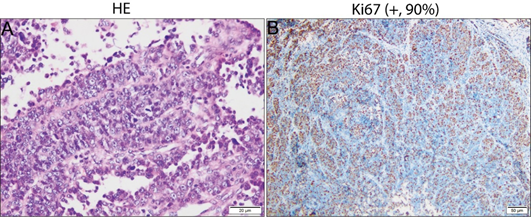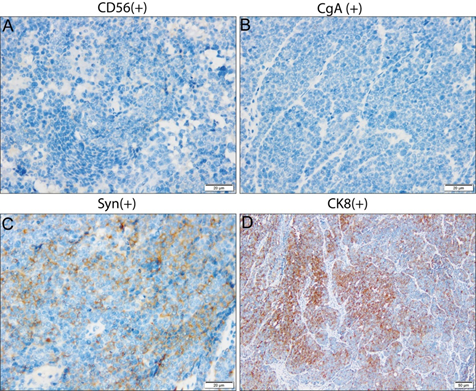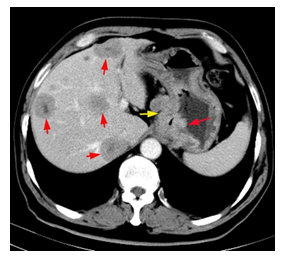Gastric Mixed Adenoneuroendocrine Carcinoma with Extensive Liver Metastases Treated with Neoadjuvant Chemotherapy and Surgery
Article Information
Ming Li, Yuanchuan Zhang, Qin Yang*
Department of general surgery, The Third People's Hospital of Chengdu and The Affiliated Hospital of Southwest Jiaotong University and The second medical school of Chengdu affiliated to Chongqing medical university, Chengdu, Sichuan 610031, P.R. China
*Corresponding Author: Dr Qin Yang, Department of general surgery, The Third People's Hospital of Chengdu and The Affiliated Hospital of Southwest Jiaotong University and The second medical school of Chengdu affiliated to Chongqing medical university, Chengdu, Sichuan 610031, P.R. China
Received: 14 June 2020; Accepted: 30 June 2020; Published: 10 July 2020
Citation: Ming Li, Yuanchuan Zhang, Qin Yang. Gastric Mixed Adenoneuroendocrine Carcinoma with Extensive Liver Metastases Treated with Neoadjuvant Chemotherapy and Surgery. Journal of Cancer Science and Clinical Therapeutics 4 (2020): 195-199.
View / Download Pdf Share at FacebookAbstract
Gastric mixed adenoneuroendocrine carcinomas (G-MANEC) are rare malignancies with about 40 cases reported to date in English literature. Clinically, G-MANEC is characterized by aggressive behavior with rapid progression including a high incidence of regional and distant metastasis, leading to tumor-related death without any chance of surgical resection. Moreover, there is no uniform standard adjuvant chemotherapy for G-MANEC. Here, we report a case of G-MANEC with extensive liver metastases that gained survival benefits from neoadjuvant chemotherapy. A brief discussion of the biological behavior and treatment of G-MANEC is presented.
Keywords
Gastric mixed adenoneuroendocrine carcinoma; Neoadjuvant chemotherapy; Multidisciplinary; Survial
Gastric mixed adenoneuroendocrine carcinoma articles, Neoadjuvant chemotherapy articles, Multidisciplinary articles, Survial articles
Gastric mixed adenoneuroendocrine carcinoma articles Gastric mixed adenoneuroendocrine carcinoma Research articles Gastric mixed adenoneuroendocrine carcinoma review articles Gastric mixed adenoneuroendocrine carcinoma PubMed articles Gastric mixed adenoneuroendocrine carcinoma PubMed Central articles Gastric mixed adenoneuroendocrine carcinoma 2023 articles Gastric mixed adenoneuroendocrine carcinoma 2024 articles Gastric mixed adenoneuroendocrine carcinoma Scopus articles Gastric mixed adenoneuroendocrine carcinoma impact factor journals Gastric mixed adenoneuroendocrine carcinoma Scopus journals Gastric mixed adenoneuroendocrine carcinoma PubMed journals Gastric mixed adenoneuroendocrine carcinoma medical journals Gastric mixed adenoneuroendocrine carcinoma free journals Gastric mixed adenoneuroendocrine carcinoma best journals Gastric mixed adenoneuroendocrine carcinoma top journals Gastric mixed adenoneuroendocrine carcinoma free medical journals Gastric mixed adenoneuroendocrine carcinoma famous journals Gastric mixed adenoneuroendocrine carcinoma Google Scholar indexed journals Neoadjuvant chemotherapy articles Neoadjuvant chemotherapy Research articles Neoadjuvant chemotherapy review articles Neoadjuvant chemotherapy PubMed articles Neoadjuvant chemotherapy PubMed Central articles Neoadjuvant chemotherapy 2023 articles Neoadjuvant chemotherapy 2024 articles Neoadjuvant chemotherapy Scopus articles Neoadjuvant chemotherapy impact factor journals Neoadjuvant chemotherapy Scopus journals Neoadjuvant chemotherapy PubMed journals Neoadjuvant chemotherapy medical journals Neoadjuvant chemotherapy free journals Neoadjuvant chemotherapy best journals Neoadjuvant chemotherapy top journals Neoadjuvant chemotherapy free medical journals Neoadjuvant chemotherapy famous journals Neoadjuvant chemotherapy Google Scholar indexed journals Multidisciplinary articles Multidisciplinary Research articles Multidisciplinary review articles Multidisciplinary PubMed articles Multidisciplinary PubMed Central articles Multidisciplinary 2023 articles Multidisciplinary 2024 articles Multidisciplinary Scopus articles Multidisciplinary impact factor journals Multidisciplinary Scopus journals Multidisciplinary PubMed journals Multidisciplinary medical journals Multidisciplinary free journals Multidisciplinary best journals Multidisciplinary top journals Multidisciplinary free medical journals Multidisciplinary famous journals Multidisciplinary Google Scholar indexed journals Survial articles Survial Research articles Survial review articles Survial PubMed articles Survial PubMed Central articles Survial 2023 articles Survial 2024 articles Survial Scopus articles Survial impact factor journals Survial Scopus journals Survial PubMed journals Survial medical journals Survial free journals Survial best journals Survial top journals Survial free medical journals Survial famous journals Survial Google Scholar indexed journals malignancies articles malignancies Research articles malignancies review articles malignancies PubMed articles malignancies PubMed Central articles malignancies 2023 articles malignancies 2024 articles malignancies Scopus articles malignancies impact factor journals malignancies Scopus journals malignancies PubMed journals malignancies medical journals malignancies free journals malignancies best journals malignancies top journals malignancies free medical journals malignancies famous journals malignancies Google Scholar indexed journals tumor articles tumor Research articles tumor review articles tumor PubMed articles tumor PubMed Central articles tumor 2023 articles tumor 2024 articles tumor Scopus articles tumor impact factor journals tumor Scopus journals tumor PubMed journals tumor medical journals tumor free journals tumor best journals tumor top journals tumor free medical journals tumor famous journals tumor Google Scholar indexed journals The National Comprehensive Cancer Network articles The National Comprehensive Cancer Network Research articles The National Comprehensive Cancer Network review articles The National Comprehensive Cancer Network PubMed articles The National Comprehensive Cancer Network PubMed Central articles The National Comprehensive Cancer Network 2023 articles The National Comprehensive Cancer Network 2024 articles The National Comprehensive Cancer Network Scopus articles The National Comprehensive Cancer Network impact factor journals The National Comprehensive Cancer Network Scopus journals The National Comprehensive Cancer Network PubMed journals The National Comprehensive Cancer Network medical journals The National Comprehensive Cancer Network free journals The National Comprehensive Cancer Network best journals The National Comprehensive Cancer Network top journals The National Comprehensive Cancer Network free medical journals The National Comprehensive Cancer Network famous journals The National Comprehensive Cancer Network Google Scholar indexed journals adjuvant chemotherapy articles adjuvant chemotherapy Research articles adjuvant chemotherapy review articles adjuvant chemotherapy PubMed articles adjuvant chemotherapy PubMed Central articles adjuvant chemotherapy 2023 articles adjuvant chemotherapy 2024 articles adjuvant chemotherapy Scopus articles adjuvant chemotherapy impact factor journals adjuvant chemotherapy Scopus journals adjuvant chemotherapy PubMed journals adjuvant chemotherapy medical journals adjuvant chemotherapy free journals adjuvant chemotherapy best journals adjuvant chemotherapy top journals adjuvant chemotherapy free medical journals adjuvant chemotherapy famous journals adjuvant chemotherapy Google Scholar indexed journals targeted therapy articles targeted therapy Research articles targeted therapy review articles targeted therapy PubMed articles targeted therapy PubMed Central articles targeted therapy 2023 articles targeted therapy 2024 articles targeted therapy Scopus articles targeted therapy impact factor journals targeted therapy Scopus journals targeted therapy PubMed journals targeted therapy medical journals targeted therapy free journals targeted therapy best journals targeted therapy top journals targeted therapy free medical journals targeted therapy famous journals targeted therapy Google Scholar indexed journals liver metastases articles liver metastases Research articles liver metastases review articles liver metastases PubMed articles liver metastases PubMed Central articles liver metastases 2023 articles liver metastases 2024 articles liver metastases Scopus articles liver metastases impact factor journals liver metastases Scopus journals liver metastases PubMed journals liver metastases medical journals liver metastases free journals liver metastases best journals liver metastases top journals liver metastases free medical journals liver metastases famous journals liver metastases Google Scholar indexed journals
Article Details
1. Introduction
The term mixed adenoneuroendocrine carcinoma (MANEC) was introduced by the World Health Organization in 2010 [1]. The prognosis of MANEC is poor and radical surgery is the only curative treatment according to The National Comprehensive Cancer Network (NCCN). However, most patients lost the chance of radical resection due to the aggressive behavior of this tumor. Therefore, multidisciplinary therapy including chemotherapy or targeted therapy is always required for those with G-MANEC. Given the rare occurrence of G-MANEC, there is no uniform standard of adjuvant chemotherapy for MANEC.
Here, we report a case of G-MANEC with extensive liver metastases who achieved radical surgery after neoadjuvant chemotherapy with CS regimen and prolonged survival with this multidisciplinary therapy.
2. Case Report
A 55-year-old man was admitted to our hospital because of experiencing stomach pain for more than 4 months. No abnormality was found during physical examination. Laboratory data were within normal limits. The routine gastroscopy found a huge ulcer in the gastric cardia and the lesions extended to the fundus. Endoscopic biopsy suggested the mixed adenoneuroendocrine carcinoma (MANEC) and the immunohistochemistry was positive for CD56, CgA, Syn and CK and the Ki-67 (+, 90%) (Figure 1 and 2).
Computed tomography (CT) revealed an unresectable stage (pT4N1M1, stage IV) (Figure 3). Chemotherapy with CS regimen was adopted with S-1 (TS-1; tegafur, gimeracil, oteracil potassium) and cisplatin. The patient showed good response to the chemotherapy and following curative surgery was achieved after three cycles. Postoperative adjuvant chemotherapy was continued for 4 more courses with CS regimen. The patient died within 31 months from the disease due to recurrence.

Figure 1: (A) The biopsy specimen is composed of two separated and different features (hematoxylin-eosin, HE stains, original magnificent, x40). (B) The immunohistochemistry of tumor cells was positive for ki67 and the ki67 labeling index was 90%.

Figure 2: Immunohistochemical findings. The tumor cells were positive for Neural cell adhesion molecule (NCAM or CD56) (A), chromogranin A (B), synaptophysin (C) and Cytokeratin 8 (D).

Figure 3: Contrast-enhanced CT image showing a focal polypoid lesion in the gastric cardia region and multiple liver masses without enhancement (red arrows). The lymph nodes around the lesser curvature were enlarged (yellow arrow).
3. Discussion
Gastric neuroendocrine neoplasms are rare malignancies which are classified into three categories: gastric neuroendocrine tumor (G-NET), gastric neuroendocrine carcinoma (G-NEC) and gastric mixed adenoneuroendocrine carcinoma (G-MANEC). G-MANEC is diagnosed histopathologically and immunohistochemically with adenocarcinoma and neuroendocrine components, with ≥ 30% of each component required. Survival is poor in patients with G-MANEC with a median survival of 12.5 months ranging from 5 to 38 months [2]. G-MANEC has been reported to be rapidly progressive and highly proliferative and the only curative option is radical resection. However, most patients are diagnosed to be unresectable because of extensive local or distant metastases. Therefore, MANECs usually require multidisciplinary therapy including chemotherapy or radiotherapy while no uniform standard of adjuvant therapy for MANEC exists due to small number of relevant studies [3].
The NCCN recommends either cisplatin / carboplatin + etoposide or etoposide +irinotecan, which are derived from regimens used for small-cell lung carcinoma without definite efficacy on MANECs. Lin [4] confirmed the efficacy of XELOX (capecitabine + oxaliplatin) on MANEC with liver metastasis which is the preferred adjuvant chemotherapy for patients with gastric cancer. However, most recommendations are for pancreatic or well-differentiated MANEC lacking a consensus statement on gastric or poor-differentiated MANEC. Several cases and phase III trial reported in Japanese about regimen with S1+cisplatin for G-MANEC showing promising results [5]. In our study, G-MANEC was histopathologically diagnosed by biopsy with extensive live metastases (pT4NxM1). Neoadjuvant chemotherapy with CS regimen (S1+cisplatin) was adopted and the patient showed good response to this regimen and the size of the liver masses reduced dramatically after three courses. Therefore, curative surgery with total gastrectomy and hepatectomy combined with radiofrequency ablative treatment (RFA) of liver metastases was performed, and pathologically confirmed the diagnosis of G-MANEC (pT4N1M1, stage IV). Postoperative adjuvant chemotherapy was continued for 4 more courses with CS regimen until severe adverse reactions appeared. Although the patient died within 31 months from the disease due to recurrence. Comparing with the average median survival of G-MANEC of 12.5 months (5 months for those with distant metastases), this neoadjuvant chemotherapy regimen in our study prolonged the survival of the patient with advanced stage.
In conclusion, we reported a case of G-MANEC with extensive liver metastases who achieved radical surgery after 3 cycles of CS neoadjuvant chemotherapy. Postoperative adjuvant chemotherapy lasted 4 courses until the severe adverse reactions appeared. Neoadjuvant chemotherapy with CS regimen for advanced G-MANEC improves survival and facilitates surgery. More clinical trials are needed to further assess the safety and efficacy of CS regimens in the treatment of MANEC.
Acknowledgement
We thank Dr. Yuanyuan Chen, from department of pathology of the Third People’s Hospital of Chengdu, for assistance of histopathologic diagnosis.
Conflict of Interest
All the authors declare that there is no conflict of interest.
References
- Rindi G, Arnold R, Fred T Bosman, et al. Nomenclature and classification of neuroendocrine neoplasms of the digestive system. In: WHO Classification of Tumours of the Digestive System (2010).
- Lin J, Zhao Y, Zhou Y, et al. Which Staging System is More Suitable for Gastric Neuroendocrine Cancer and Mixed Adenoneuroendocrine Carcinomas? A Multicenter Cohort Study. Neuroendocrinology (2020).
- Sato O, Tsuchikawa T, Yamada T, et al. Metastatic mixed adenoneuroendocrine carcinoma of the liver successfully resected by hepatic trisectionectomy following chemotherapy: A case report. Clinical case reports 7 (2019): 491-496.
- Lin Z, Chen J, Guo Y. Efficacy of XELOX adjuvant chemotherapy for gastric mixed adenoneuroendocrine carcinoma: A case report. Medicine 98 (2019): e16000.

